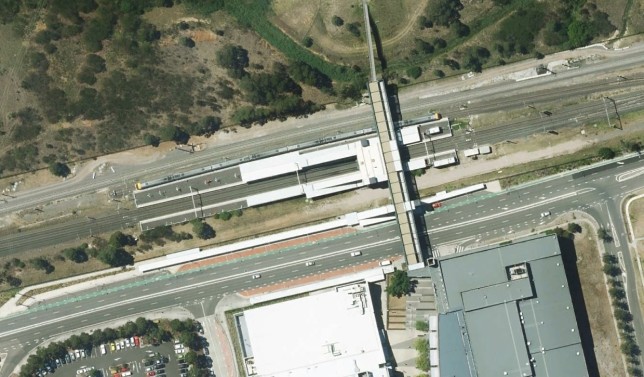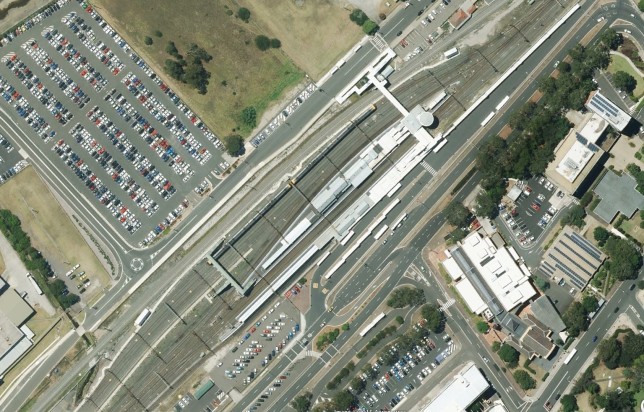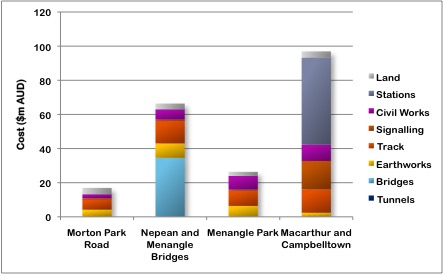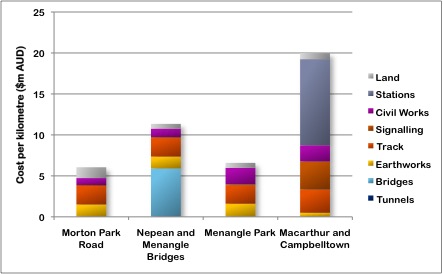← Upper Nepean Previous | Next Glenfield →
The last sector before we reach metropolitan Sydney presents few design difficulties, or at least no more so than the adjacent Hume Highway. A couple of bridges and moderately deep cuttings are all that is needed to bring the high-speed railway back to the Southwest Rail Corridor, where the prevailing radius is about 1800m. Campbelltown is a major outer-metropolitan station on the Sydney commuter rail network, and it will be redeveloped to a major interchange in order to connect the line with the existing suburban network.
Alignment design
Summary
The total cost of the 17.5km sector is $206.6 million ($11.81 million per kilometre). The largest single cost component is the redevelopment of Campbelltown Station, due to the density of existing development there. It is not possible to avoid this cost, as the station lies directly on the rail corridor with little room either side. Otherwise the sector is fairly conventional in terms of cost allocation – a substantial portion goes towards bridges due to the large span over the Nepean, but there are only moderate earthworks and civil works required in this sector. All in all, a fairly good result to come in only slightly above the Hot Rails average.
Other options that were considered included a slightly different alignment rejoining the rail corridor without impacting the UWS campus, or a much different alignment following the existing railway for most of the sector, with three major deviations to allow high-speed operation. This option was considered inferior due to more numerous, tighter radius turns, and not particularly lower construction costs (the deviations would require substantial land acquisitions, civil works and bridging).
Morton Park Road – 2.8km
Exiting Douglas Park, the alignment passes through a sparsely-built area before joining the Hume Highway corridor on the eastern side. The highway is in a cutting at this point; the cutting will have to be widened to accommodate the rail corridor. There is little required in the way of civil works; a grade separation for Morton Park Road and the normal fencing and drainage requirements are all.
Nepean and Menangle Bridges – 5.85km
The line cuts across farmland between Douglas Park and Menangle Road in order to straighten out the curve in the Hume corridor. Strictly speaking this is not necessary (the minimum radius of the Hume is about 1800m here, enough to allow a tilting trains to travel at over 250km/h, or TGV-style trains at about 220km/h). However, this would not offer substantial savings over a faster alignment with radius of over 5000m (which would allow TGV-style trains to travel at 350km/h).
Several cuttings and embankments are required, up to 12m in depth (though more typically about 5m). The bridge over the Nepean river is substantial, requiring a mainspan of 120m and being 360m in total length. The second bridge (over the Menangle creek) is less substantial, being 300m of 20m-long spans. Also at Menangle Creek, the alignment gradually changes grade from -1.25 to +1.25 degrees over about 1000m; this well exceeds the typical transition length, and is sufficient for train speeds up to 300km/h.
Menangle Park – 4.0km

Southbound view of the Menangle Rd overpass, showing the part needing to be widened. Image: Google Maps.
Subsequent to the Menangle Creek Bridge, the alignment rejoins the Hume corridor. Approximately 1.1km of Medhurst Road will require realignment, and the grade separations at Menangle Rd and Glenlee Rd will both have to be widened to accommodate the railway. The line then proceeds adjacent to the Hume Highway for the remainder of the section.
Macarthur and Campbelltown – 4.85km

UWS Campbelltown campus masterplan showing future residential developments in pale yellow. Note position of Macarthur Station and rail line. Source : Campbelltown City Council
This section passes through the Campbelltown campus of the University of Western Sydney. Although the affected part is presently undeveloped, a concept masterplan suggests this area will eventually become playing fields, parkland and residential development. If future development of the UWS precinct renders this option impracticle, a backup option is to depart the Hume corridor earlier and utilise the existing rail corridor along Menangle Rd. This would likely require realignment of the existing railway, and more substantial land acquisitions, but the corridor would remain viable without expensive solutions like tunneling.
We have a choice here – do we join the existing railway line on the northern or southern side? The answer will be dictated by the state of existing infrastructure further up the suburban line, and which side it will therefore be easiest to construct a new double-railway on. Between Macarthur and Glenfield, the existing rail corridor contains a double-track suburban line with a single-track freight line to the west, bypassing the passenger stations. All the stations are split-platform with little or no room for additional tracks. It’s going to be very difficult to turn this triple-track railway into a quintuple-track mega-corridor without some serious rebuilding of the existing stations – unfortunately, this won’t be cheap.
Macarthur Station has plenty of room on both the north and south for additional tracks. It has a stabling track to the north of the station as well as the freight track, two straight, central suburban tracks, and room for two more tracks to the south of the main platform (it appears this space has been left for future development).

Macarthur station, showing central suburban tracks and northern stabling and freight tracks. Image: Google Maps
Campbelltown Station however is rather more difficult. It is already a large interchange station with many active platforms as well as extensive stabling facilities. There is plenty of room in the corridor, but existing development will have to be substantially rebuilt to allow a pair of high-speed tracks to transit. Looking at just the image below, probably the easiest option would be to rebuild the stabling area over part of the existing car park and have the high-speed tracks to the northwest. However looking further up the line, there is more room to the east of the line, making it more desirable to have the new tracks on that side. Still another option would be to upgrade the existing suburban tracks to high-speed, and build new tracks and platforms to service the lower-speed suburban services. This option is attractive in that the existing centre tracks are straight and easily isolated from the rest of the system, and the curvature of new side platforms would be more easily handled by low speed services.
We’ll also specify a new, 1000-space multi-level car park, more than doubling the existing parking capacity at the station, to aid its use as a park-and-ride commuter station.

Campbelltown Station showing extensive development. Image: Google Maps
Still another option would be to just put the high-speed lines up on a viaduct wherever there is insufficient room. This would be expensive, but then so will all the other options. If the viaduct has 20m spans, it will cost almost $30 million per kilometre. Very expensive, yes, but that’s pretty much the only cost. If things keep getting more difficult closer to Sydney, we might have to take this drastic option. For now we’ll assume that the existing suburban tracks become the high-speed tracks, and new suburban platforms are built at both Macarthur and Campbelltown Stations.







